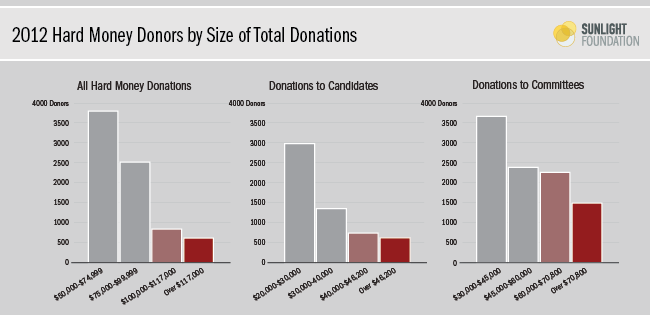How many donors will benefit if the Supreme Court allows unlimited campaign contributions?
Yesterday, my colleague Lisa Rosenberg previewed what’s at stake in the upcoming Supreme Court case, McCutcheon v. Federal Election Commission. On Oct. 8, judges will rule on the constitutionality of the overall limit on contributions to federal candidates and political parties. Currently, the limits are set at $74,600 to political committees, and $48,600 to candidates – $123,200 overall. If the court sides with the plaintiffs, those limits will be a thing of the past.
Everybody is buzzing about what will happen if the courts lift the aggregate limits. Will more donors start writing multi-million dollar checks? Will the campaign finance system flood with even more money?
As we noted earlier this year, More than a quarter (28.1 percent, to be exact) of the nearly $6 billion in contributions from identifiable sources in the 2011-2012 cycle came from just 31,385 individuals, a number equal to one ten-thousandth of the U.S. population. Everybody in this elite class contributed at least $12,950. As I wrote in our “1% of the 1%” report:
The nation’s biggest campaign donors have little in common with average Americans. They hail predominantly from big cities, such as New York and Washington. They work for blue-chip corporations, such as Goldman Sachs and Microsoft. One in five works in the finance, insurance and real estate sector. One in 10 works in law or lobbying. The median contribution from this group of elite donors? $26,584. That’s a little more than half the median family income in the United States…The 1% of the 1% are the political gatekeepers of American politics. Through countless independent phone calls and fundraising events, they set the boundaries of acceptable political topics and positions (i.e., what they care about and believe). They determine who is an acceptable candidate (i.e., those individuals whom they trust to represent their interests).
If the Supreme Court lifts the aggregate caps, these 1% of the 1% donors will become even more important. Most likely, lifting aggregate caps will take an incredibly incredibly unequal system of campaign finance and turn it into incredibly incredibly incredibly incredibly unequal system.
Though nobody knows what will happen until it happens, we do at least know what took place last time around. The 2012 electoral cycle was the first presidential contest to feature super PACs, entities that (unlike candidates and political parties) can accept unlimited donations. During that two-year cycle, 2,047 donors gave $100,000 or more overall, including money to super PACs. That, by the way, is roughly equivalent to what the median U.S. family earns during the same two-year period. Among these top 2,047 donors, the median donation total in 2012 was $134,300.

Briefly, a quick review of campaign finance law: In 2012, we read a lot about Sheldon and Miriam Adelson, who spent a remarkable $97 million between them. Almost all of that money went into super PACs, a new type of political organization that grew out of the Citizens United decision. While the Adelsons could each only give $5,000 to a single candidate and $30,800 to a party committee in 2012, they could give unlimited amounts to super PACs like American Crossroads. The caveat was that the super PACs had to be “independent” of campaigns. They couldn’t coordinate strategy with candidates and parties, at least not directly.
The argument against lifting the aggregate caps on combined contributions to political and candidate committees is that it will allow enterprising candidates, parties, and donors to set up multiple committees allowing candidates to benefit directly from donor contributions. This raises the specter of the million dollar campaign donation.
The question, then, is which donors would be likely to make this million-dollar contribution? Well, here’s what we saw in 2012:
- 95 donors gave at least $1,000,000;
- 192 donors gave at least $500,000;
- 390 donors gave at least $250,000;
- 1,323 donors gave at least $117,000 (the aggregate individual limit to candidates and parties); and
- 2,047 donors gave at least $100,000.
Not surprisingly, The more the donor spent, the more of that money went to super PACs.
And what if we look at just money to candidates, and parties, so called “hard money” donations – the types of contributions at stake in McCutcheon?
As we wrote back in May, almost 600 donors appeared to have violated the aggregate limit in 2011-2012. I write appeared because loopholes and data limitations made it difficult to be certain. This became apparent when Charles G. Koch complained that we had improperly listed him as a violator, when, in fact, he had taken advantage of an existing loophole: the ability for recount funds not to count towards aggregate totals.
It’s also worth noting that FEC has historically done very little to enforce the limits. The agency has no system of tracking donors. It relies on outside complaints. Many donors are not even aware of the limits.
But loophole or no loophole, enforcement or no enforcement, we count 592 donors who gave more than $117,000 in hard money donations in 2011-2012, which was then the limit. And 32 of them gave more than $200,000.
Additionally, our analysis finds:
- 601 individuals who gave more than $46,200 in aggregate to candidates (the legal limit); and
- 1,473 individuals more than $70,800 to parties (also the legal limit).
There is much overlap in people between the two lists. As for donors who came close to the legal limit in 2012, we also count:
- 821 donors who gave between $100,000 and $117,000 in aggregate to candidates and parties,
- 2,243 donors who gave between $60,000 and $70,800 to committees in aggregate
- 723 donors who gave between $40,000 and $46,200 to candidates in the aggregate.
Taken together, these findings suggest an increasing role for a very limited number of campaign donors. We’ll have more to say about these donors tomorrow.
Graphic by Ben Chartoff and Amy Cesal.

